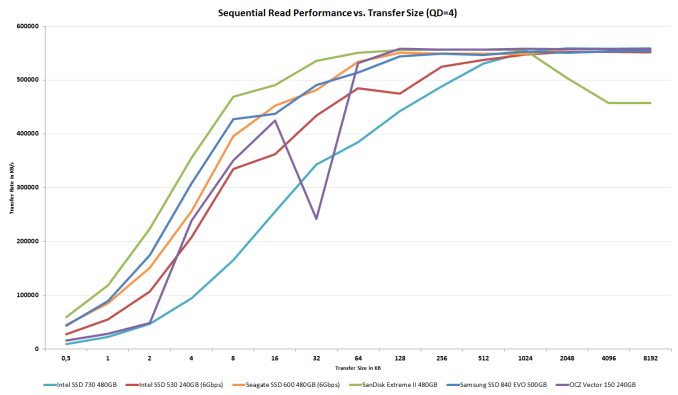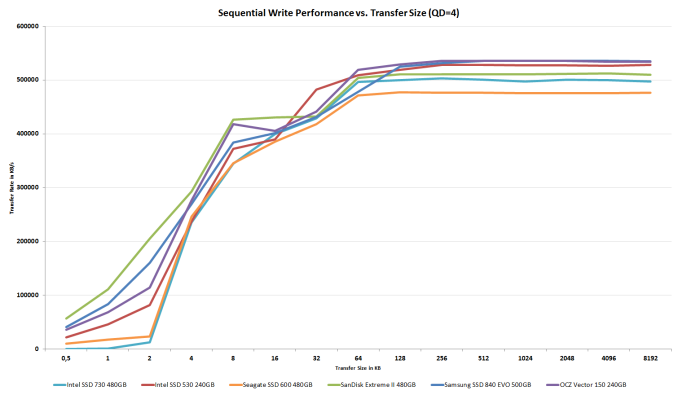Intel SSD 730 (480GB) Review: Bringing Enterprise to the Consumers
by Kristian Vättö on February 27, 2014 12:00 PM EST- Posted in
- Storage
- SSDs
- Intel
- Intel SSD 730
Performance vs. Transfer Size
ATTO is a useful tool for quickly benchmarking performance across various transfer sizes. You can get the complete data set in Bench. ATTO illustrates the poor-ish read performance of the SSD 730 quite well. The SSD 730 is the slowest drive in this comparison and doesn't match the other drives until an IO size of 1024KB. Write performance on the other hand is average, although it should be noted that at the smallest IO sizes the drive is very slow for some reason. I'm guessing this is just a matter of optimization as enterprise workloads don't usually go to IO sizes smaller than 4KB.
Click for full size












96 Comments
View All Comments
Namey - Friday, February 28, 2014 - link
AgreededDeath666Angel - Friday, February 28, 2014 - link
Hm, so the Oxford Dictionary recognized word "monies" sounds uneducated to you? And it seems that documentated and adaptated are perfectly fine and acceptable words as well. Just because you don't use them in every day language or they sound weird does not mean they are not correct. There are many different types of spoken and written English language. And making fun of one of the (correct) ways to write that language does seem, what's the word, uneducated. :PMipmap - Thursday, February 27, 2014 - link
"build a drive significantly that was better than the other offerings."build a drive that was significantly better than the other offerings.
JarredWalton - Thursday, February 27, 2014 - link
Man, I seriously flubbed that sentence/paragraph on the editing pass. I think I tried to copy/paste to rearrange words but somehow missed. LOLGuspaz - Thursday, February 27, 2014 - link
The endurance figures must be wrong. They're quoting that the drive supports only 267 cycles before it dies (128TB / 480GB = ~267), which is absurdly low. This is supposed to be high endurance MLC, but even Samsung's TLC has multiple times higher endurance than that...KAlmquist - Thursday, February 27, 2014 - link
Perhaps Intel is assuming 3000 cycles and a worst case write amplification of 12. (If you aren't familiar with write amplification, see Anand's early SSD articles on this site.)Guspaz - Thursday, February 27, 2014 - link
Intel previously claimed a write amplification of 1.1 way back in the G1 days. Are you saying that this drive has an order of magnitude worse write amplification than their oldest drives?futrtrubl - Friday, February 28, 2014 - link
Remember that they are using enterprise metrics and not client metrics on this. It could be the you can be more flexible on the WA you can assume on client drives.Guspaz - Friday, February 28, 2014 - link
Perhaps, but don't you think that the order of magnitude reduction in claimed write endurance deserves a call out in the article, if only to explain why that's the case?KAlmquist - Friday, February 28, 2014 - link
The 1.1 write amplification was presumably typical rather than worst case. I wouldn't expect the write amplification to be that much different from the G1. The large block and page sizes probably make write amplification a bit worse, but the algorithms may have improved a bit.I agree with your comment below that it would have been nice if the reviewer had queried Intel about the endurance spec, rather than leaving us to speculate.